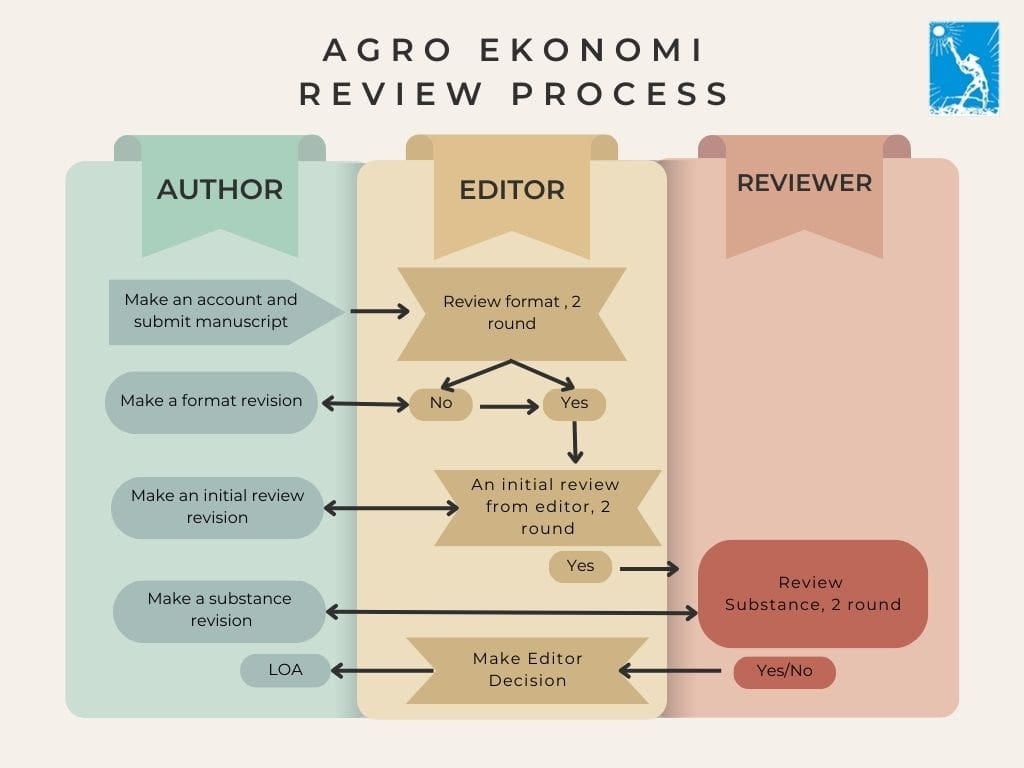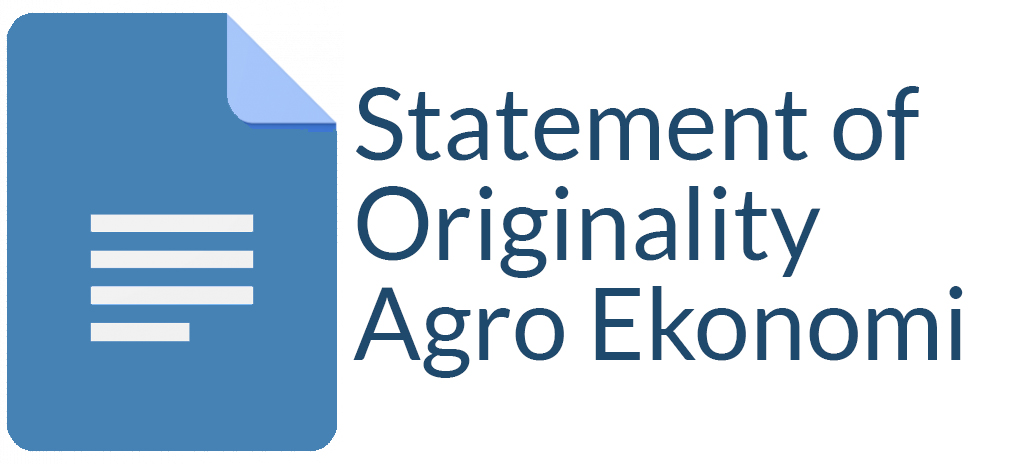The Competitiveness of Indonesian Agricultural Products in G-20 Market
Endang Pudji Astuti(1*), Rita Nurmalina(2), Amzul Rifin(3)
(1) Indonesian Agency for Agricultural Research and Development (IAARD)
(2) Department of Agribusiness, Faculty of Economics and Management, IPB University
(3) Department of Agribusiness, Faculty of Economics and Management, IPB University
(*) Corresponding Author
Abstract
Membership in the G-20 forum is both a threat and an opportunity for Indonesian agricultural commodities. Indonesia must be able to take advantage of this great opportunity to increase international trade activities, especially exports. Although the G-20 market is a potential market, Indonesia faces challenges because it is considered not ready to compete and threatened to become a market for other countries. In 2020, Indonesia's agricultural exports (HS 01-24) are in ninth place compared to its competitors in G-20 market. In order to increase the export share, the purpose of this study is to analyze the development of exports from Indonesia to the G20 market and the competitiveness of agricultural products. The analyzes used are descriptive analysis, Revealed Comparative Advantage (RCA), and Dynamic Revealed Comparative Advantage (DRCA). The results showed that 63.25% of the five selected agricultural export commodities had comparative competitiveness in the G-20 market. From the trend of increasing exports, several countries that become non-traditional markets have the potential as a market diversification destination, including Saudi Arabia, Mexico, Turkey, and Argentina. DRCA analysis shows that the dynamics of the G-20 market are quite large, and some of them are experiencing a decline. The strategy to increase exports to the G-20 market is to maintain the competitiveness of commodities in the rising star quadrant, as well as increase the competitiveness of commodities that are in the lagging opportunity and lost opportunity quadrant due to high global demand for these commodities.
Keywords
Full Text:
PDFReferences
Amin, K. (2015). Kebijakan Liberalisasi Perdagangan Indonesia di Sektor Pertanian. Jurnal Interdependence, 3(1), 70–81.
Andari, W. (2015). Analisis pengaruh dan tingkat keberhasilan perdagangan Indonesia dalam ASEAN-India Free Trade Agreement (AIFTA). Jurnal Ekonomi IPB, 1(1), 1–6.
Christiyanto, N., Bangsa, P. G., & Christiana, A. (2020). Perancangan Brand Identity Sarang Burung Walet CV Dwi Anugrah Bird Nest di Surabaya. Jurnal DKV Adiwarna, 1.
Gumelar, S. A., Affandi, M. I., & Situmorang, S. (2020). Pengaruh Hambatan Non Tarif di Pasar Uni Eropa Terhadap Ekspor Komoditas CPO Indonesia. JIIA, 8(1), 86–92.
Güneş, S., & Tan, M. (2017). Static and Dynamic Revealed Comparative Advantage : A Comparative Analysis of Turkey and Russia. Iktisadi Yenilik Dergisi, 3(4), 22–38.
Harapuspa, A., & Fitriani, D. (2018). Analisis faktor-faktor yang mempengaruhi ekspor sarang burung di indonesia. Jurnal Fokus, 8(2), 150–162.
Isventina, I., Nuryartono, N., & Hutagaol, M. P. (2015). Analisis Daya Saing Sektor Industri Prioritas Indonesia dalam Menghadapi Pasar ASEAN. JEKP, 4(1), 71–93.
Mashari, S., Nurmalina, R., & Suharno, S. (2019). Dinamika Daya Saing Ekspor Udang Beku dan Olahan Indonesia di Pasar Internasional. Jurnal Agribisnis Indonesia, 7(1), 37–52.
Nurfadila, Safrida, & Zulkarnain. (2021). Analisis Trend Volume Ekspor Biji Kopi dari Indonesia ke Amerika Serikat. Jurnal Agrisep, 22(1), 1–6.
Panjaitan, D. V., Ingot, S. R., Mardiansyah, A., & M. Christoffel, L. (2020). Analisis Dampak Export Restriction Komoditi Pertanian Terhadap Indonesia. JAI, 8(1), 1–16. https://doi.org/10.29244/jai.2020.8.1.1-16
Paryadi, D., & Salam, A. R. (2018). The Impact of Indonesia-Eurasian Economic Union (EAEU) Trade Cooperation on the Indonesian Economy. Buletin Ilmiah Litbang Perdagangan, 12(2), 161–180.
Pudjiastuti, A. Q. (2014). Perubahan Neraca Perdagangan Indonesia sebagai Akibat Penghapusan Tarif Impor Gula. Agriekonomika, 3(2), 106–116.
Purba, W., & Ardiyanti, D. (2019). Dinamika Kerjasama Perdagangan Indonesia dalam Ekspor Kelapa Sawit ke India Tahun 2014-2019. Jurnal FISK, 2(1), 133–140.
Putra, T. J., Sushanti, S., & Resen, P. T. K. (2019). Kepentingan Jerman Melalui Program FORCLIME Dalam Penanganan Deforestasi di Kalimantan (2010-2016). Jurnal Hubungan Internasional, 1(1), 1–14.
Rifin, A. (2013). Competitiveness of Indonesia’s Cocoa Beans Export in the World Market. International Journal of Trade, Economics and Finance, 4(5), 279–281. https://doi.org/10.7763/ijtef.2013.v4.301
Rosiana, N., Nurmalina, R., Winandi, R., & Rifin, A. (2017). The Level of Comparative Advantages of World Main Coffee Producers. Buletin Ilmiah Litbang Perdagangan, 11(2), 227–246.
Sabaruddin, S. S. (2013). Simulasi Dampak Liberalisasi Perdagangan Bilateral RI-China terhadap Perekonomian Indonesia: Sebuah Pendekatan SMART Model. JEKT, 6(2), 86–97.
Sabaruddin, S. S. (2017). Penguatan Diplomasi Ekonomi Indonesia Mendesain Clustering Tujuan Pasar Ekspor Indonesia: Pasar Tradisional vs Pasar Non-Tradisional. Jurnal Ilmiah Hubungan Internasional, 12(2), 1–16. https://doi.org/10.26593/jihi.v12i2.2654.205-219
Salim, Z. (2010). Indonesia in the G20: benefits and challenges amidst national interests and priorities. In G20: Perceptions and Perspectives for Global Governance (Issue January 2010).
Sari, A. R., Hakim, D. B., & Anggraeni, L. (2014). Analisis Pengaruh Non-Tariff Measures Ekspor Komoditi Crude Palm Oil (CPO) Indonesia Ke Negara Tujuan Ekspor Utama. JEKP, 3(2), 111–135. https://doi.org/10.29244/jekp.3.2.2014.111-135
Sasmito, G. S., Laut, L. T., & Destiningsih, R. (2019). Daya Saing Crude Palm Oil (CPO) Indonesia dan Malaysia di Lima Pasar Utama Tahun 2001-2018. Dinamic: Directory Journal of Economic, 1(3), 338–347.
Sidiq, M. A. N., Findi, M., & Firdaus, M. (2019). The Analysis of New Market Potentials and Determinants of Indonesian Export Commodities in the South Asian Region. International Journal of Scientific Research in Science, Engineering and Technology, 6(5), 254–263. https://doi.org/10.32628/ijsrset196552
Sunardi, D., Oktaviani, R., & Novianti, T. (2014). Analisis Daya Saing Dan Faktor Penentu Ekspor Komoditas Unggulan Indonesia Ke Organisasi Kerjasama Islam (Oki). JEKP, 3(2), 95–110. https://doi.org/10.29244/jekp.3.2.95-110
Sushanti, S. (2019). Aktualisasi Indonesia Dalam G20 : Peluang Atau Tren ? Jurnal Ilmiah Widya Sosiopolitika, 1(1), 1–14.
Syachbudy, Q. Q., Firdaus, M., & Daryanto, H. K. S. (2017). Analisis Faktor-Faktor Ekspor Produk Pertanian Pendahuluan. JAI, 5(1), 57–74.
Syadullah, M. (2018). Potensi Pelaksanaan Dialog Kebijakan Indonesia–Negara-Negara Di Kawasan Afrika. Fiskal.Kemenkeu.Go.Id, 1–19.
Wibisono, B. A. S. (2017). Penurunan Perdagangan Bilateral Indonesia- Korea Selatan Dalam Kerjasama Working Level Task Force Meeting (WLTFM). EJournal Ilmu Hubungan Internasional, 5(4), 1381–1396.
Widyaningtyas, D., & Widodo, T. (2016). Analisis Pangsa Pasar Dan Daya Saing Cpo Indonesia Di Uni Eropa. Jurnal Ekonomi Manajemen Sumber Daya, 18(2), 138–145. https://doi.org/10.23917/dayasaing.v18i2.4510
Article Metrics
Refbacks
- There are currently no refbacks.
Copyright (c) 2018 Agro Ekonomi

This work is licensed under a Creative Commons Attribution-ShareAlike 4.0 International License.
View My Stats











